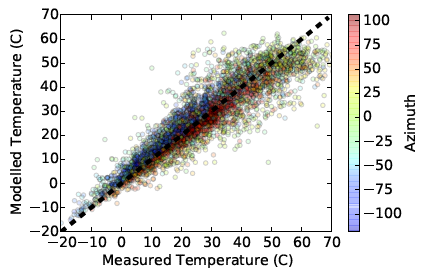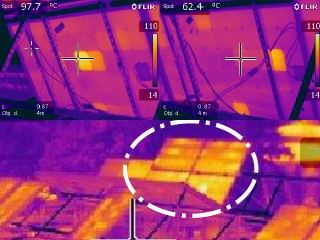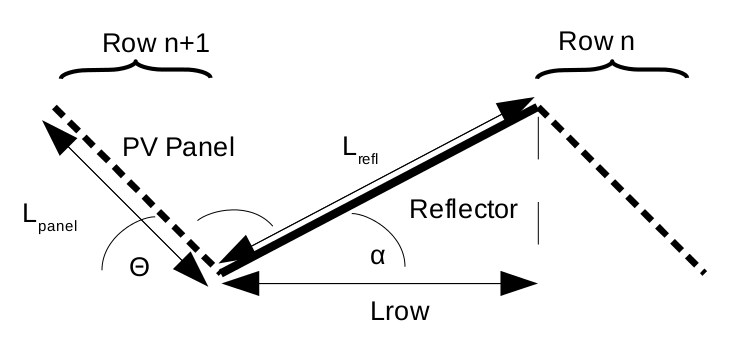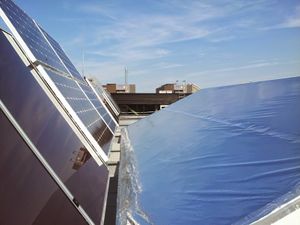J.M.Pearce (talk | contribs) m (→In the news) |
J.M.Pearce (talk | contribs) m (→Source) |
||
| Line 4: | Line 4: | ||
==Source== | ==Source== | ||
[[image:Bdrf-pv.png|right]] | [[image:Bdrf-pv.png|right]] | ||
* Rob W. Andrews, Andrew Pollard and Joshua M. Pearce. Photovoltaic System Performance Enhancement With Non-Tracking Planar Concentrators: Experimental Results and Bi-Directional Reflectance Function (BDRF) Based Modelling. ''IEEE Journal of Photovoltaics'' (in press). DOI: [http://dx.doi.org/ | * Rob W. Andrews, Andrew Pollard and Joshua M. Pearce. Photovoltaic System Performance Enhancement With Non-Tracking Planar Concentrators: Experimental Results and Bi-Directional Reflectance Function (BDRF) Based Modelling. ''IEEE Journal of Photovoltaics'' (in press). DOI: [http://dx.doi.org/10.1109/JPHOTOV.2015.2478064] [https://www.academia.edu/16836963/Photovoltaic_System_Performance_Enhancement_With_Non-Tracking_Planar_Concentrators_Experimental_Results_and_Bi-Directional_Reflectance_Function_BDRF_Based_Modelling open access] | ||
==Abstract== | ==Abstract== | ||
Revision as of 13:31, 26 October 2015
Source

- Rob W. Andrews, Andrew Pollard and Joshua M. Pearce. Photovoltaic System Performance Enhancement With Non-Tracking Planar Concentrators: Experimental Results and Bi-Directional Reflectance Function (BDRF) Based Modelling. IEEE Journal of Photovoltaics (in press). DOI: [1] open access
Abstract


Non-tracking planar concentrators are a low-cost method of increasing the performance of traditional solar photovoltaic (PV) systems. This paper presents new methodologies for properly modeling this type of system design and experimental results using a bi-directional reflectance function (BDRF) of non-ideal surfaces rather than traditional geometric optics. This methodology allows for the evaluation and optimization of specular and non-specular reflectors in planar concentration systems. In addition, an outdoor system has been shown to improve energy yield by 45% for a traditional flat glass module and by 40% for a prismatic glass crystalline silicon module when compared to a control module at the same orientation. When compared to a control module set at the optimal tilt angle for this region, the energy improvement is 18% for both system. Simulations show that a maximum increase of 30% is achievable for an optimized system located in Kingston, ON using a reflector with specular reflection and an integrated hemispherical reflectance of 80%. This validated model can be used to optimize reflector topology to identify the potential for increased energy harvest from both existing PV and new-build PV assets.
Discussion
In the news
- Shining More Light on Solar Panels - Michigan Tech News, ECN Magazine, Phys.org, Science Codex, Nanowerk, R&D Magazine, Innovations Report, Chem Europe
- Solar Panels Can Produce More Energy Through New Technique - Science World Report
- Una nuova tecnica per potenziare i pannelli solari: potranno produrre il 30% di energia in più - Tiscali Scienza(Italy)
- Fotovoltaico, gli scienziati aggiungono un 30% all’energia in uscita - Rinnovabili (Italy)
- Raising solar panel system output by 30% - Market Business News
- Study Shows Reflectors Could Maximize Solar Panels Productivity - AZO Cleantech
- New Method Enables Use of Reflectors to Shine More Light on Solar Panels - World Industrial Reporter
- Solar Panels Just Got a Little Bit Brighter - The Epoch Times
- Boosting solar panel efficiency: Is it simply a matter of angles? -- EE Times Europe
- http://www.eetindia.co.in/ART_8800716755_1800008_NT_d79964a0.HTM - EE Times India
- Researchers Discover How to Shine More Sunlight on Solar Panels, Increase Output By 30% - IHS Electronics 360
- Light reflection model boosts solar farm efficiency - Smart 2 Zero
See also

- Photovoltaic system performance enhancement with non-tracking planar concentrators: Experimental results and BDRF based modelling
- Low level concentration for PV applications
- Effects of low concentration planer concentrators on array-scale solar photovoltaic systems performance





